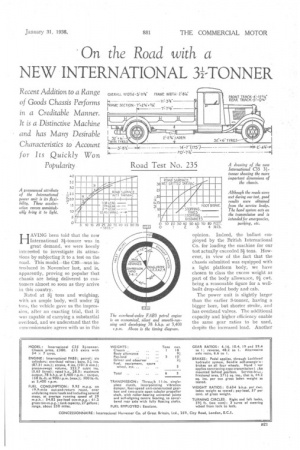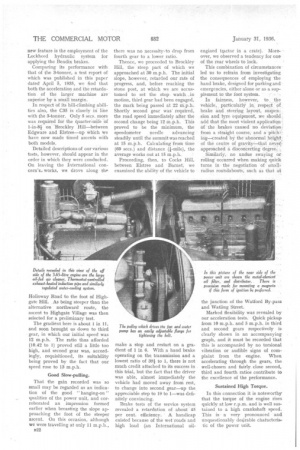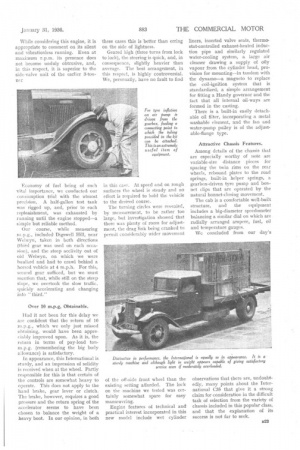On the Road with a
Page 31

Page 32

Page 33

If you've noticed an error in this article please click here to report it so we can fix it.
NEW INTERNATIONAL 31-TONNER
AVING been told that the new International 34-tonner was in great demand, we were keenly interested to investigate its attractions by subjecting it to a test on the road. This model—the C35---was introduced in November last, and is, apparently, proving so popular that chassis are being delivered to customers almost so soon as they arrive in this country.
Bated at 34 tons and weighing, with an ample body, well under 24 tons, the vehicle gave us the impression, after an exacting trial, that it was capable of carrying a substantial overload, and we understand that the concessionnaire agrees with us in this opinion. Indeed, the ballast employed by the British International Co. for loading the machine for our test actually exceeded 34 tons. However, in view of the fact that the chassis submitted was equipped with a light platform body, we have chosen to class the excess weight as part of the body allowance, 9i cwt. being a reasonable figure for a wellbuilt drop-sided body and cab.
The power unit is slightly larger than the earlier 3-tonner, having a bigger bore, but shorter stroke, and has overhead valves. The additional capacity and higher efficiency enable the same gear ratios to be used, despite the increased load. Another new feature is the employment of the Lockheed hydraulic system for applying the Bendix brakes.
Comparing its performance with that of the 3-tonner, a test report of which was published in this paper dated April 5, 1935, we find that both the acceleration and the retardation of the larger machine are superior by a sinall Margin.
In respect Of its hill-climbing abilities also, the C35 is closely in 1Me with the 3-tonner. Only 5 secs. more was required for the quarter-mire 'of on 'Brockley Hill—between Edgware and Elstree—up which we have now made timed ascents with both models.
Detailed descriptions of our various tests, however, should appear in the order in which they were conducted. On leaving the International concern's. works, we drove along the Holloway Road to the foot of Highgate Hill. As being steeper than the alternative northward route, the ascent to Highgate Village was then selected for a preliminary test.
The gradient here is about 1 in 11, and soon brought us down to third gear, in which our initial speed was 12 m.p.h. The ratio thus afforded (10.42 to 1) proved still a little too high, and second gear was, accordingly, requisitioned, its suitability being proved by the fact that our speed rose to 13 m.p.h.
Good Slow-pulling.
That the gain recorded was so small may be regarded as an indication of the good " hanging-on " qualities of the power unit, and corroborated an impression formed earlier when breasting the slope approaching the foot of the steeper ascent. On this occasion, although we were travelling at only 11 m.p.h.,
B22 there was no necessity-to drop from fourth gear to a lower ratio.
Thence, we proceeded to Brockley Hill, the steep part of which we approached at 30 m.p.h. The initial slope, however, retarded our rate of progress, and, before reaching the stone post, at which we are accustomed to set the stop watch in motion, third gear had been engaged, the mark being passed at 22 m.p.h. Shortly, second gear was required, the road speed immediately after the second change being 12 m.p.h. This proved to be the minimum, the speedometer needle advancing steadily until the summit was reached at 15 M.p.h. Calculating from time (60 secs.) and distance (k-mile), the average works out at 15 m.p.h.
Proceeding, then, to Cocks Hill, between Elstree and Barnet; we examined the ability of the vehicle to make a stop and restart on a gradient of 1 in 6. With a hand brake operating on the transmission and a lowest ratio of 39t to 1, there is not much credit attached to its success in this trial, but the fact that the driver was able, almost immediately the vehicle had moved away from rest, to change into second gear—up the appreciable step to 19 to 1—was definitely convincing.
Brake tests of the service system revealed a retardation of about 45 per cent. efficiency. A handicap existed because of the wet roads and high load (an International oil engined teactor in a crate). Moreover, we observed a tendency for one of the rear wheels to lock.
This combination of circumstances led us to refrain from investigating the consequences of employing the hand brake, designed for parking and emergencies, either alone or as a supplement to the foot system.
In fairness, however, to the vehicle, particularly in respect of brake and steering layout, suspen: sion and tyre equipment, we should add that the most violent application of the brakes caused no deviation: from a straight course, and a pitch.Mg—created by the abnormal height of the centre of gravity—that never, approached a disconcerting degree.
• Similarly, no undue swaying or rolling occurred when making quick turns in the negotiation of smallradius routulabouts, such as that at the junction of the Watford By-pass and Watling Street.
Marked flexibility was revealed by our acceleration tests. Quick pickup from 10 m.p.h. and 5 m.p.h. in third and second gears respectively is clearly shown in an accompanying graph, and it must be recorded that this is accompanied by no torsional vibration or audible signs of complaint from the engine. When accelerating through the gears, the well-chosen and fairly close second, third and fourth ratios contribute to the excellence of the performance.
Sustained High Torque.
In this connection it is noteworthy that the torque of the engine rises quickly at lpw r.p.m. and is well sus. tabled to a high crankshaft speed. This is a very pronounced and unquestionably desirable chaiacteri.se tic of the power unit. While considering this engine, it is appropriate to comment on its silent and vibrationless running. Even at maximum r.p.m. its presence does not become unduly obtrusive, and, in this respect, it is superior to the side-valve unit of the earlier 3-tonner Economy of fuel being of such vital importance, we conducted our eonsumption trial with the utmost precision.. A half-gallon test tank was rigged up, and, prior to each replenishment, was exhausted by running until the engine stopped—a simple but reliable method.
Our course, while measuring »i.p.g., included! Digswell Hill; pear Welwyn, taken in both directions (third gear was used on each occasion), and the steep acclivity out of old Welwyn, on which we were baulked and had to crawl behind a horsed vehicle at 4 m.p.h. For this, second gear sufficed, but we must mention that, while still on the steep slope, we overtook the slow traffic, quickly accelerating and changing into " third."
Over 10 m.p.g. Obtainable.
Had it not been for this delay we are confident that the return of 10 ni.p.g., which we only just missed obtaining, would have been appreciably improved upon. As it is, the return in terms of pay-load tonm.p.g. (remembering the big body allowance) is satisfactory.
In appearance, this International is sturdy, and an impression of solidity is received when at the wheel. Partly responsible for this is that certain of the controls are somewhat heavy to operate. This does not apply to the hand brake, gear lever or clutch. The brake, however, requires a good pressure and the return spring of the accelerator seems to have been chosen to balance the weight of a heavy boot. In our opinion, in both these cases this is better than erring on the side of lightness.
Geared high (three turns from lock to lock), the steering is quick, and, in consequence, slightly heavier than average. The best arrangement, in this respect, is highly controversial. We, personally, have no fault to find in this case. At speed and on rough surfaces the wheel is steady and no effort is required to head the vehicle to the desired coarse.
The turning circles were revealed, by measurement, to be rather too large, but investigation showed that there was plenty of room for adjustment, the drag link being cranked to permit considerably wider movement of the off-side front wheel than the existing setting afforded. The lock on the machine we tested was certainly somewhat spare for easy manceuvring.
Engine features of technical and practical interest incorporated in this new model include wet cylinder liners, inserted valve seats, thermostat-controlled' exhaust-heated induction pipe and similarly regulated water-cooling system, a large air cleaner drawing a supply of oily vapour from the cylinder head, provision for mounting—in tandem with the dynamo—a magneto to replace the coil-ignition system that is standardized, a simple arrangement for fitting a Handy governor and the fact that all internal oil-ways are formed in the casting.
There is a built-in easily detachable oil filter, incorporating a metal washable element, and the fan and water-pump pulley is of the adjustable-flange type.
Attractive Chassis Features.
Among details of the chassis that are especially worthy of note are variable-size distance pieces for spacing the twin rims on the rear wheels, rebound plates to the road springs, built-in helper springs, a gearbox-driven tyre pump and bonnet clips that are operated by the natural bonnet-closing movement.
The cab is a comfortable well-built structure, and the equipment includes a big-diameter speedometer balancing a similar dial on which are radially arranged ampere, fuel, oil and temperature gauges.
We concluded from our day's observations that there are, undoubtedly, many points about the International C35 that give it a strong claim for consideration in the difficult task of selection from the variety of chassis included in this popular class, and that the explanation of its success is not far to seek.




















































































